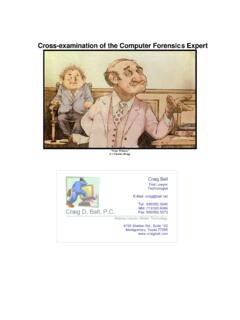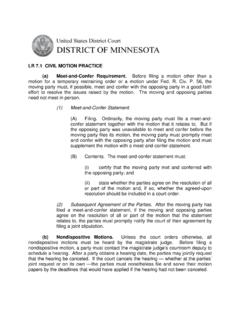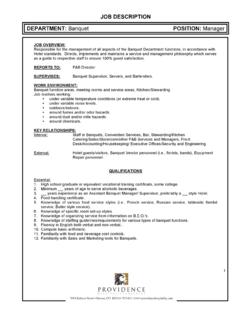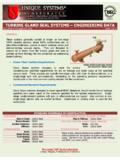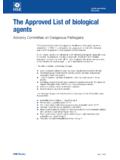Transcription of Musings on Meet and Confer[1] - Craig Ball
1 1 Musings on meet and confer It s More Important for Lawyers to Ask the Right Questions than Know the Right Answers By Craig Ball 2007 I cynically describe Rule 26(f) meet and confer sessions as two lawyers who don t trust each other negotiating matters neither understand. In the unlikely event where there s a face-to-face meeting, it s something of a drive-by event with no substantive exchange of information. On the rare occasions that knowledgeable people attend, the lawyers often make it difficult to interact in a constructive way. But, meet and confer is critically important. The early, open and accurate sharing of information about ESI is a linchpin of success in electronic discovery.
2 meet and confer requires intense preparation built on a broad and deep gathering of detailed information about systems, applications, users, issues and actions. An hour or two of hard work should lay behind every minute of a Rule 26(f) conference. Forget winging it on charm or bluster, and forget, We ll get back to you on all that. meet and confer also requires something harder to mandate: effective communication and a commitment to work cooperatively and in good faith. Until lawyers better understand and can communicate about information systems and electronic data, they need to enlist some help, and they may need some adult supervision.
3 Judges must take a strong even Draconian stand on e-discovery meet and confer duties, pushing the parties beyond the ignorance, posturing and Rambo tactics so often seen and forcing them to pull on the same discovery oar or start swimming. Here, much good comes from 2reining in the lawyers and demanding that technically-savvy people get together to forge compromises and find solutions. Please, your Honors, let heavy boots meet recalcitrant behinds! Rule 26(f) Conference Preparation Prior to a Rule 26(f) conference, the parties need to identify the sources of electronically stored information. That entails much more than, We use computers.
4 Identification of ESI is more than just a head count of machines, backup tapes, custodians, network storage areas and thumb drives. Certainly, it's important to have a current inventory, but identification of potentially responsive sources of ESI goes deeper. Moreover, it s not a one-sided responsibility. Virtually everyone uses computers and holds some electronic evidence. The parties should be prepared to speak knowledgeably and specifically about the nature and extent of potentially relevant ESI. The fifty questions that follow illustrate the range and complexity of topics that may be addressed and should make crystal clear there s a lot of homework to be completed before the conference: 1.
5 What are the issues in the case? 2. Who are the key players in the case? 3. Who are the persons most knowledgeable about ESI systems? 4. What events and intervals are relevant? 5. When did preservation duties and privileges attach? 6. What data is at greatest risk of alteration or destruction? 7. Are systems slated for replacement or disposal? 8. What steps have been or will be taken to preserve ESI? 9. What third parties hold information that must be preserved, and who will notify them? 10. What data requires forensically-sound preservation? 11. Are there unique chain-of-custody needs to be met? 12. What metadata is relevant, and how will it be preserved, extracted and produced?
6 13. What are the data retention policies and practices? 14. What are the backup practices, and what tape archives exist? 15. Are there legacy systems to be addressed? 16. How will the parties handle voice mail, instant messaging and other challenging ESI? 17. Is there a preservation duty going forward, and how will it be met? 18. Is a preservation or protective order needed? 19. What e-mail applications are used currently and in the relevant past? 20. Are personal e-mail accounts and computer systems involved? 21. What principal applications are used in the business, now and in the past? 22. What electronic formats are common, and in what anticipated volumes?
7 23. Is there a document or messaging archival system? 24. What relevant databases exist? 25. Will paper documents be scanned, at what resolution and with what OCR and metadata? 26. What search techniques will be used to identify responsive or privileged ESI? 27. If keyword searching is contemplated, can the parties agree on keywords? 28. Can supplementary keyword searches be pursued? 29. How will the contents of databases be discovered? Queries? Export? Copies? Access? 30. How will de-duplication be handled, and will data be re-populated for production? 31. What forms of production are offered or sought? 32. Will single or multi-page TIFFs, PDFs or other image formats be produced?
8 333. Will load files accompany document images, and how will they be populated? 34. How will the parties approach file naming, unique identification and Bates numbering? 35. Will there be a need for native file production? Quasi-native production? 36. On what media will ESI be delivered? Optical disks? External drives? FTP? 37. How will we handle inadvertent production of privileged ESI? 38. How will we protect trade secrets and other confidential information in the ESI? 39. Do regulatory prohibitions on disclosure, foreign privacy laws or export restrictions apply? 40. How do we resolve questions about printouts before their use in deposition or at trial? 41. How will we handle authentication of native ESI used in deposition or trial?
9 42. What ESI will be claimed as not reasonably accessible, and on what bases? 43. Who will serve as liaisons or coordinators for each side on ESI issues? 44. Will technical assistants be permitted to communicate directly? 45. Is there a need for an e-discovery special master? 46. Can any costs be shared or shifted by agreement? 47. Can cost savings be realized using shared vendors, repositories or neutral experts? 48. How much time is required to identify, collect, process, review, redact and produce ESI? 49. How can production be structured to accommodate depositions and deadlines? 50. When is the next Rule 26(f) conference (because we need to do this more than once)?
10 For somewhat different approaches to the electronic discovery topics to be addressed at a Rule 26(f) conference, see the work of Magistrate Judge Paul W. Grimm s committee entitled, Suggested Protocol for Discovery of Electronically Stored Information, found at , as well as the for the District of Kansas Guidelines for Discovery of Electronically Stored Information found at


